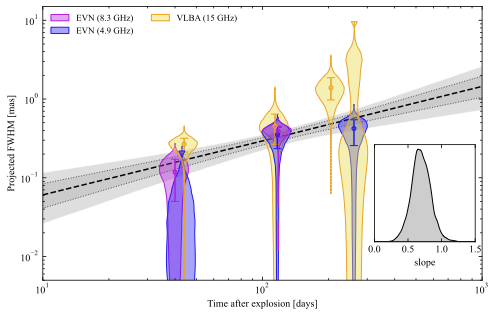
The expansion of the GRB 221009A afterglow
Stefano Giarratana
Long-duration gamma-ray bursts (GRBs) are powerful explosions that serve as fundamental laboratories to study the physics of ultra-relativistic jets. They are believed to mark the catastrophic death of a massive star and the subsequent formation of a spinning stellar mass black hole or neutron star. This newborn central engine may power and launch relativistic jets of ejected matter that expand and interact with the circumburst medium, producing both a forward shock and a reverse shock. The electrons at the shock fronts are accelerated to relativistic energies, producing a long-lived, multi-wavelength afterglow via synchrotron emission.
Due to the energy involved, GRB afterglow shocks are expected to expand with an apparent superluminal motion. However, a direct measurement of the size and the expansion rate had been possible only once hitherto - specifically for GRB 030329A - using the very long baseline interferometry (VLBI) technique (Taylor et al., 2004).
On October 9, 2022, the brightest GRB ever recorded, GRB 221009A, triggered all satellites equipped for transient detection, prompting the community to carry out an extensive multi-wavelength follow-up. To measure its apparent superluminal expansion, we conducted a multi-epoch, multi-band (5, 8 and 15 GHz) study with the European VLBI Network (EVN) and the Very Long Baseline Array (VLBA). The high angular resolution achieved allowed us to measure the size of the shocked material and confirm its apparent superluminal expansion for the second time ever, twenty years after the first.
Figure 1: Size of GRB 221009A as a function of time. The source size constraints are shown in the form of violin plots of different colours, centred at the observing time of each epoch and with a width that is proportional to the posterior probability density of the full width at half maximum (FWHM) of the source image. In addition, we show the median and 68% credible interval with an error bar of the same color, or the 95% credible upper limit with a triangle if the former interval extends to 0. The black dashed line and the two grey shaded areas show respectively the median, 68% credible interval and 95% credible interval of the posterior predictive distribution of the source size evolution obtained from fitting a power law model to the sizes from all the epochs. The inset shows the posterior probability density of the slope from such fit.
The expansion rate we derived is consistent with the expectation for a spherical relativistic blast wave (Blandford & McKee 1976) propagating into a medium with either a homogeneous or a wind-like density profile. This suggests that the shock may be anisotropic on angular scales larger than those probed by our observations, indicating that the so-called jet break has not happened yet. The absence of a jet break would imply an extremely large total energy in the jet, especially if the surrounding medium has a homogeneous density profile. This energy requirement could be alleviated if the external density is significantly lower than typically assumed or if the jet energy per unit solid angle decreases slowly with the angle from the jet axis, as proposed by O’Connor et al. (2023) and Gill & Granot (2023). Alternatively, the shock may have undergone sideways expansion during the observation period.
Finally, our observations suggest a frequency dependent size evolution, with the VLBA observations at 15 GHz showing a somewhat larger size at 40 days after the explosion, and a faster increase afterwards, with respect to the EVN observations at 5 and 8 GHz. This could be due to the emission being dominated by the reverse shock at the lower frequencies, and by the forward shock at the higher frequencies.
References:
Blandford, R. D., & McKee, C. F. 1976, Phys. Fluids, 19, 1130
Gill, R., & Granot, J. 2023, MNRAS, 524, L78
O’Connor, B., Troja, E., Ryan, G., et al. 2023, Sci. Adv., 9, eadi1405
Taylor, G. B., Frail, D. A., Berger, E., & Kulkarni, S. R. 2004, ApJ, 609, L1
More information: Giarratana S., et al. 2024, A&A, 690, A74
Contact: Stefano Giarratana, stefano.giarratana@inaf.it